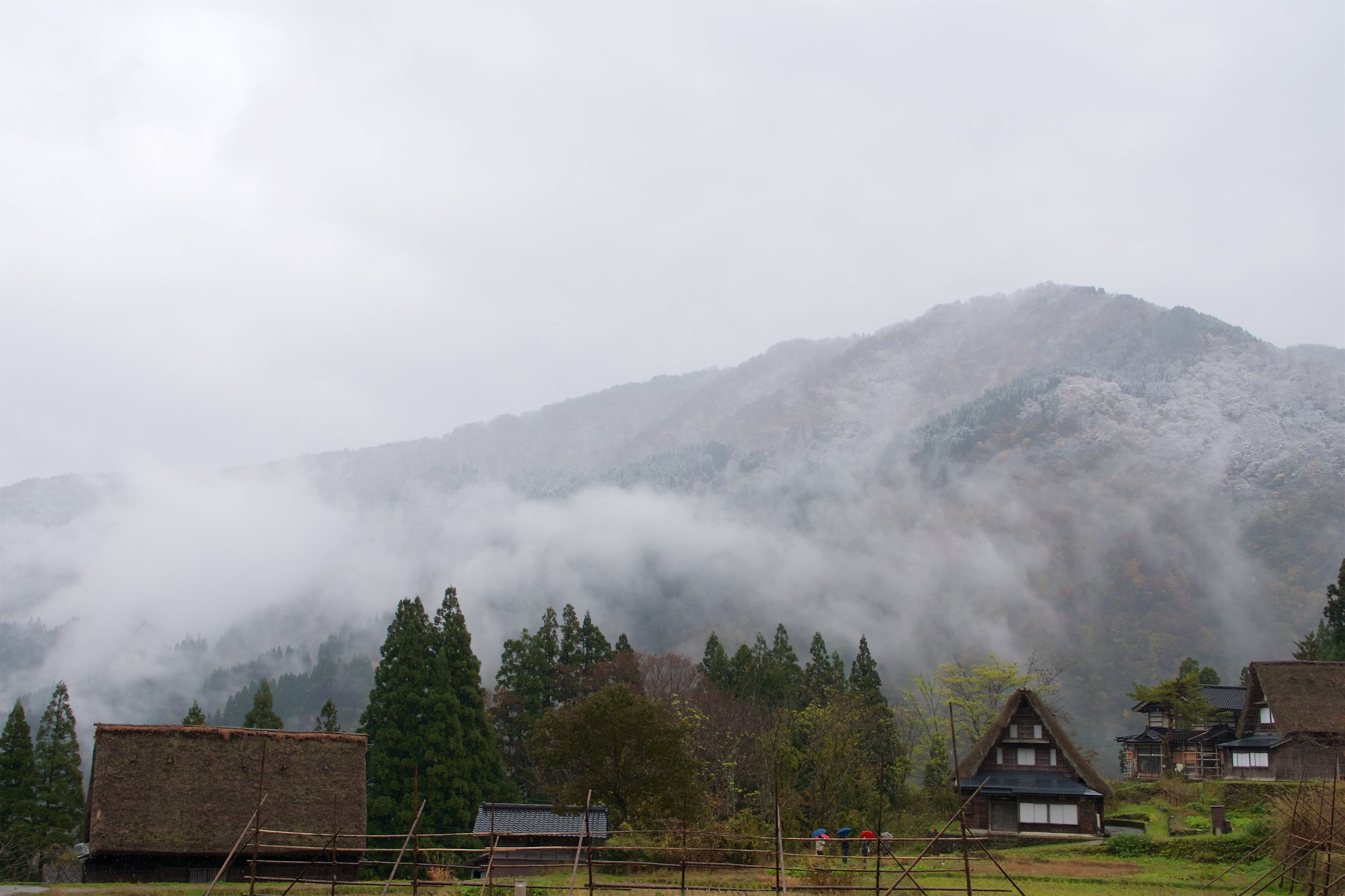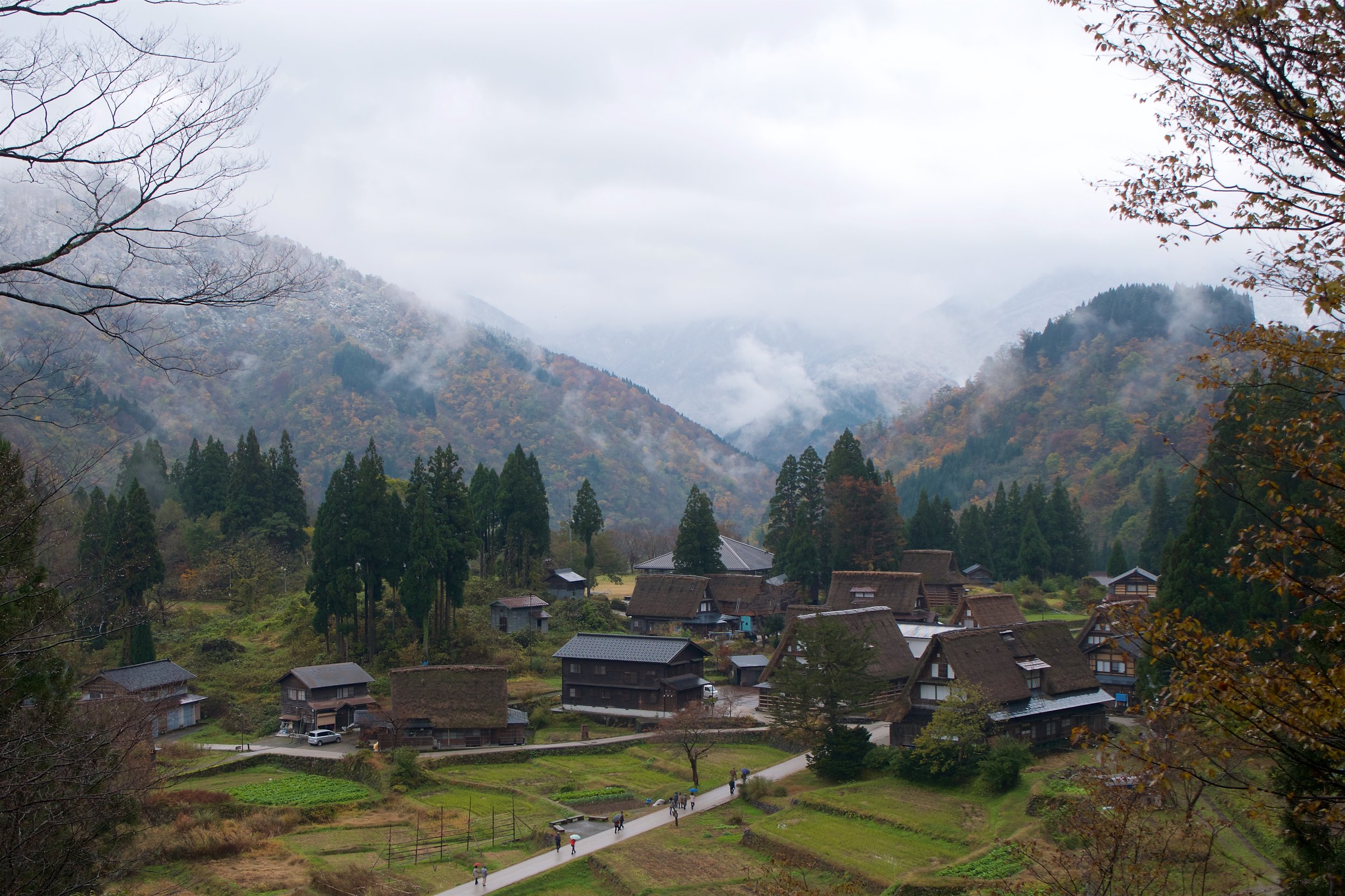Kanazawa to Ainokura, Wednesday 9-Nov
After a few days on the west coast of Japan, it was time to head to the mountains. Instead of a hostel or a business hotel, this time we were spending the night in a farmhouse in the mountains.
Since we wanted to catch the train not too late in the morning, we got up early so we should shower, eat, and finish packing. Oh, and since you were wondering, the washlet was indeed working.
It was lightly sprinkling on our way to the Kanazawa Station, and as we got near the bus area, we saw one stop had a huge line with well over 100 people in it, several of them kids going to school.
Getting to Ainokura
We found our train platform and the train was there with our train number on it. The doors were open, so we tried going inside, but they hadn't cleaned it yet (probably turning around the train on the other side of the platform) so we got out so they could do that. When the time came, we got back in and there were plenty of seats. We were only riding for about ten minutes, but it was still nice to sit down.
Arriving at Shin-Takaoka, the first leg of the trip done. We then looked around to make sure we knew where our bus was, and it was pretty clear. We then went to the information desk and were surprised that they sell the necessary bus pass there (we thought we would have to buy it from the driver).
We had a little time before the bus arrived, so we went out to the bus waiting area. There only a few other people there, but since the bus began one stop earlier, we wouldn't know how full it was until it showed up. Ends up there were plenty of seats as we got on. Many of them, however, got taken up by the next couple stops. For when we leave Ainokura, we'll be taking the same bus in the same direction, but an earlier one. It was somewhat disconcerting to see so many seats filled.
As the bus started climbing into the mountains, it started to rain a bit more. Then it started to snow. Not a lot of snow, but some. We looked at the mountains and you could definitely see the snow line; we were well below it but had no idea whether Ainokura was above or below that line.
The bus pulled up to our stop. There was still snow falling, but it wasn't sticking. Still cold, especially what we've been used to over the past few weeks, but not freezing. We were happy to see most of the bus exit at our stop (several of them had trouble with figuring out the fare; our passes made that easy). In addition, no one got onto the bus at that stop, so that made us hopeful that the next day would be the same, and we'd have no trouble finding a spot when we board.
Around Ainokura
We walked up the driveway to the entrance of the village, and it was pretty easy to figure out where our lodging was. The hostess was about to head out for some errands but quickly showed us to our room, turned on the heater, and said she'd be back soon. We warmed up for a while, making a strategy for the rest of the day.
The hostess returned before we were ready to leave, so she quickly served tea and crackers. That finished, we went out to the café we had walked past to get some lunch. We both had soba, and Melody had served herself some tea. Not being a big tea drinker, I didn't get any, but the owner saw I didn't have any and quickly poured some for me.
Warmed and fed, we sought out the pair of museums at the other end of the village. Finding the Ainokura Traditional Crafts Museum, we paid for the ticket which gives us admission into both and entered. It seemed pretty small (it used to be one of the farmhouses), but there was still quite a bit packed in there. We then climbed the ladder to the second floor, where we saw more artifacts, including how the upper floor used to be used to cultivate silkworms and spin silk thread. I also found the underside of the thatched roofs interesting to examine.
As we got back downstairs, we sat by the heater for a bit, and the woman who took our admission came by with a bunch of pages which explained some things about the village. She then sang a traditional Japanese folk song for us and demonstrating how to use a kokiriko, a percussion instrument made of pieces of wood on a flexible backing. Flicking one side of the kokiriko makes the blocks move, similar to dominos falling, and it's an extended clicking sound. We were given kokirikos to try, too.
Now both Melody and I have what we think are pretty good musical ears, but neither of us is familiar with Japanese folk music. But we thought the song she sang was the same as we heard being played (on repeat) in the café where we had lunch and a couple times on the bus ride down. We would hear that song several more times during our stay.
We wandered a few houses away to look at the Ainokura Folklore Museum. Yes, the woman watching over that museum was humming the folk song. It was pretty similar to the other museum but did have some interesting information about how the farmhouses are made, including creating the supports for and thatching the roofs.
After the museums, we wanted to go up to the viewpoint to get a look of the whole village. The map seemed to indicate the path looped around from near the second museum. We started up, saw one or two landmarks we were supposed to, but the path kept going up the hill, instead of heading around to the other end of town, so we decided to backtrack and go up the other side to the viewpoint. As we were doing that, some sort of siren started to sound. It wasn't clear what that was for, since it stopped, and by the time we got back to the village, people were roaming around as if nothing had happened.
Going up the other path to the observatory was more fruitful. We were rewarded with quite a good view, and then we looped around to walk among the terraced vegetable gardens (mostly rice) on the way back down.
It was time to warm back up a bit, so we went back to the café and had some amazake. We asked for that, and then, since the menu offered an option, asked for it hot. The owner seemed to chuckle that anyone would want cold amazake on such a cold day. As we were drinking, we noticed the television was tuned to the election results. Imagine how surreal it felt, seeing that while we were in a small cafe in a small Japanese mountain village.
Back in the farmhouse
We returned to the farmhouse and relaxed a bit before dinner. We heard another couple with a baby come in, settling into the room next to us.
Dinner time came around, and we were all served. The meal was typical of what would be served at inns in the area with vegetables and mushrooms which grew wild in the mountains, as well as fish from the streams. There was miso soup with nameko mushrooms, nimono (boiled local tofu, mushroom, bamboo shoots, zenmai fern, and other vegetables), tempura (local mountain vegetables, plus one with beans), sunomono (mountain vegetables in vinegar), kogomi no goma-ae (fern in sesame paste), koi-no-arai (carp sashimi with shredded daikon), plain tofu, iwana-no-sioyaki (trout with salt grilled in an open pit), pickled vegetables, rice, and tea. Sounds like a lot, but the portions weren't huge, so it ended up being a good amount.
Over dinner, we got to talking with the other couple. They live in Switzerland, but he's German and she's Thai. She had been in Japan before, but it was his first time.
While we were eating, our hostess made up the futons for us, then drew water for the bath. Since the other couple was still eating, we went first to soak. It was a bit different since the water wasn't from hot springs (so it didn't have minerals in it) but still nice. She must know just how much water to put in; by the time we were both in the tub, the water was within an inch of overflowing.
After the food and the hot bath, we did a bit of online work (research for Melody, photos and writing for me). The wireless was understandably not very fast (it being a remote mountain village) and my hot spot didn't have any access to data (again, a remote mountain village) so we didn't do too much. After that, we were ready to go to sleep. Part of making up the futons was putting a heat source under the covers, near the foot of the bed. It was oddly warm, even after the hour or two that it was there. Warm enough that we just turned off the heat; that, and it runs on kerosene. In a wood house with paper-covered sliding doors and a thatched roof. Then again, there was an open fire pit in the middle of the main room.
Ah well, figuring the place hadn't burned down after all that time (and guests hadn't suffocated), we fell asleep.










